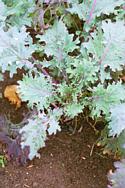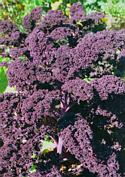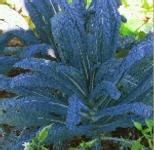Background
Compared to its more succulent cousins like cabbage and broccoli, Kale is often regarded as a “coarse” vegetable, suitable only for the winter garden. How untrue! The leaves are rich with Vitamin A & C, iron and calcium and the beautifully frilled Japanese varieties are an ornament in any garden and make a striking garnish on any dish. On top of that, kale’s ability to give tender greens in the early spring makes it a valuable commodity when no other greens are able to produce.

cauliflower.
Kale is one of the easier Brassicas to grow since it doesn’t need to head like cabbage and doesn’t fall over, as Brussels sprouts plants tend to do. In fact, kale prefers a slightly lower fertility than cabbage since high nitrogen produces tender leaves that do not withstand frost well. Soil that has been manured and limed the previous year is perfect for growing kale.
Here on the West Coast, we usually start kale in early July so that they reach a good size before the first frost in October. Adjust your starting date accordingly. The plants should be spaced a minimum of 1 foot apart but will grow in more crowded conditions. However, the more room you give the plants, the more they will produce. Most plants
mature between 50-80 days.
Although kale is cold hardy and can survive temperatures as low as 0 F, if mild weather is followed by a sudden freeze, it can kill the plants. Cover your plants with a floating row cover or a cloche and mulch around the plants to protect them against freeze-thaw cycles. If temperatures do go below 0 F, you can bury the plants in mulch. Brush the mulch aside when you need to harvest.

Varieties
In his book dated 1885, Vilmorin listed 26 varieties of kale including leaf kales, tree kales, and marrowstem kales. Few of these varieties are still around today although heirlooms such as “Lacinato” are making a comeback thanks to seed saving groups. Most kales varieties belong to 1 of 4 types: Scotch (very curly leaves), Russian (flat leaf, serrated edges), Japanese (ornamental rosette types) and Other – (Lacinato, walking stick etc). Here is a list of some of my favourite varieties:
- Dwarf Blue Curled Scotch – squat plant, cold hardy, easy to mulch if temperatures drop, can be grown in a 5-gallon container.
- Winterbor F1 – Scotch type, hybrid variety, very winter hardy
- Redbor – a red Winterbor, extremely ornamental although the taste isn’t as good.
- Red Russian – purple veins at beginning of season turn red in the fall, flat leaves probably most tender of all kale varieties and can be eaten fresh in salads
- Nagoya – Japanese type, deep center, frilly comes in white or red, nice tasting
- Peacock – Japanese type, deeply serrated leaves, large head, better for wet climates.
- Lacinato (Nero diTosca) – Italian heirloom, dark blue-gray leaves, puckered & up to 2 ft long, hardy and ornamental
Pests
Few insect pests bother kale. Slugs and aphids can be hosed off easily on this sturdy plant. Imported cabbageworm seems to be the only pest that will do serious damage to kale. Handpick the worm or prevent the butterfly from laying its eggs by using a floating row cover. Otherwise, spray with BTK for an organic treatment.

